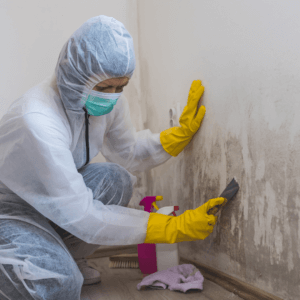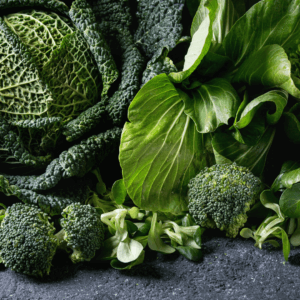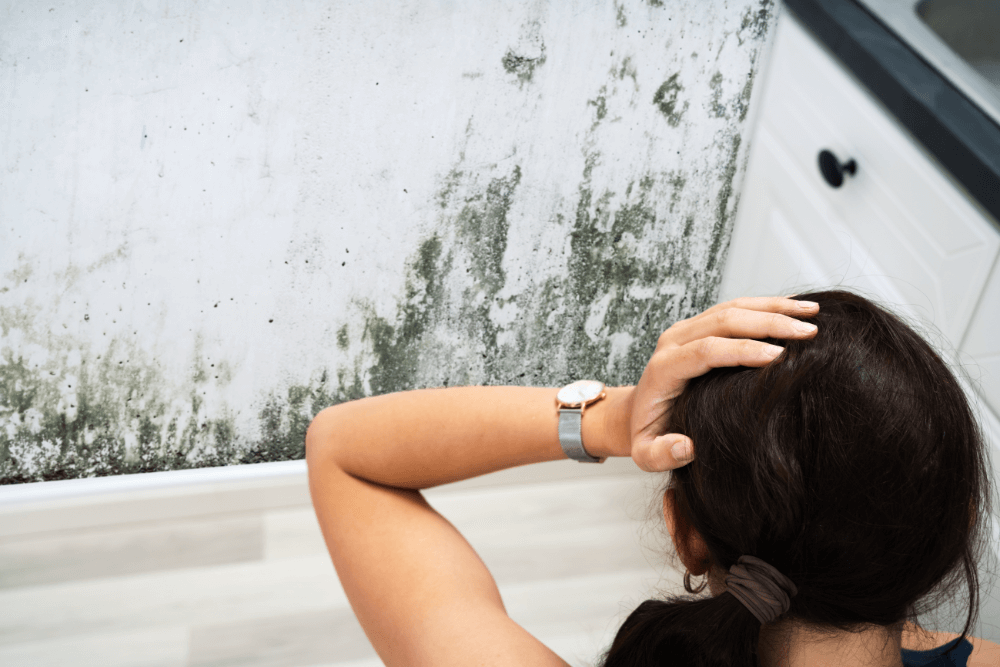 Mold may seem like just an annoying household nuisance. However, it can be far more insidious than that.
Mold may seem like just an annoying household nuisance. However, it can be far more insidious than that.
Hidden behind walls, under sinks, in damp corners, and elsewhere, mold can silently degrade your health—sometimes in serious ways.
Let’s take a closer look at the most common symptoms of mold exposure, how to know if you have a mold problem in your home, and the best ways to treat it and prevent future issues.
What is Mold?
Mold is a type of fungus that grows in moist, humid environments. It reproduces by releasing tiny spores into the air.
These spores are present almost everywhere, and when they land on damp surfaces indoors, mold can grow rapidly.
While mold is naturally occurring and has some beneficial uses (like in penicillin), indoor mold growth—especially in confined, poorly ventilated spaces—can become a serious health hazard.
How Mold Can Make You Sick: 9 Symptoms of Mold Exposure

While some people may only experience mild symptoms, others—especially those with asthma, allergies, compromised immune systems, or chron
ic illnesses—can face far more serious consequences. The effects also depend on the type of mold, the length of exposure, and individual sensitivity.
1. Respiratory Issues
Coughing, wheezing, shortness of breath, and chest tightness are all hallmark symptoms. Mold spores can irritate the lungs, especially in people with asthma or chronic respiratory conditions.
2. Nasal Congestion and Sinus Problems
Sneezing, stuffy nose, postnasal drip, or sinus pressure often result from the body’s reaction to inhaled spores or mold-related allergens.
3. Fatigue and Weakness
Many people exposed to mold report unexplained fatigue that does not improve with rest—likely due to chronic immune activation or mycotoxin exposure.
 4. Headaches
4. Headaches
Frequent or persistent headaches (including migraines) are another common symptom. They may stem from inflammation, sinus pressure, or mycotoxin effects on the brain.
5. Skin Rashes or Irritation
Mold exposure may cause itchy, red, or inflamed skin. Direct contact or airborne particles settling on the skin can trigger irritation.
6. Watery or Itchy Eyes
Red, irritated, or itchy eyes are a classic sign of airborne mold spores. This is especially common in environments with poor air circulation.
7. Brain Fog and Difficulty Concentrating
Cognitive symptoms such as memory problems, confusion, or trouble concentrating are often reported by people with chronic mold exposure, especially when mycotoxins affect neurological function.
 8. Digestive Distress
8. Digestive Distress
While less commonly linked, some people experience bloating, nausea, or changes in appetite due to immune stress or systemic inflammation caused by mold exposure.
9. Mood Changes
Mold-related illness can trigger mood swings, anxiety, or depression—possibly through inflammation in the brain or disruption to neurotransmitters like serotonin and dopamine.
Long-Term Health Risks of Mold Exposure
When mold exposure continues over time—especially without proper remediation—it can lead to more serious, chronic health problems, including:
- Chronic Inflammatory Response Syndrome (CIRS) – CIRS is a multi-system, multi-symptom illness triggered by exposure to biotoxins like mold. It is characterized by immune system dysregulation and ongoing inflammation and may cause symptoms across the brain, respiratory, digestive, and hormonal systems.
- Asthma Development or Asthma Worsening – Repeated exposure to mold—particularly in children—has been linked to the development of asthma. For those already living with asthma, mold can trigger frequent and severe flare-ups.
- Weakened Immune Function – Some molds release mycotoxins, which can suppress your immune response, making individuals more susceptible to infections and illness over time.
- Neurological Decline – Mycotoxins from certain mold types may contribute to neuroinflammation, memory loss, poor focus, and in severe cases, long-term cognitive decline.
- Increased Risk of Allergies or Autoimmune Reactions – Mold exposure may prime the body to become more reactive to other allergens, or even contribute to the onset of autoimmune symptoms in predisposed individuals.
Where Mold Often Hides in Homes
 Mold thrives in damp, dark environments and may not always appear in plain sight in your home.
Mold thrives in damp, dark environments and may not always appear in plain sight in your home.
Although it may require a bit of work to get to these places, it is often worth it to check for mold growth, especially if you suspect that you or your family are suffering from mold exposure symptoms.
Here is a checklist of key places to look for mold growth in your home:
- Behind drywall (especially after leaks)
- Under carpets and padding
- In bathrooms (shower corners, under sinks)
- Around the edges of windows and doors
- Inside HVAC systems and air ducts
- In basements and crawl spaces
- Behind kitchen appliances
- In attics (due to poor ventilation or roof leaks)
- In houseplant soil
How to Clean Up Existing Mold (natural methods that work)
If you have discovered mold in your home, do not panic—take action.
Small patches of mold on non-porous surfaces can often be cleaned naturally and effectively using safe ingredients you may already have at home.
However, larger infestations or mold on porous materials often require professional remediation.
Before you begin cleaning, it is important to protect yourself and avoid spreading mold spores throughout your home.
Safety First: Protect Yourself

Always take precautions when cleaning mold—even small amounts.
- Wear gloves, an N95 mask, and protective eyewear
- Ventilate the area with open windows or fans blowing air outward
- Seal off the room if possible to prevent spores from spreading
- Never dry-brush or scrape mold without proper containment—it releases spores into the air
Best Natural Mold Removal Methods
Here are several safe, effective, and affordable natural remedies for cleaning mold.
Choose the one that best suits the surface and severity.
Once the area is cleaned, keep it dry and well-ventilated. Moisture is mold’s best friend—no matter how well you clean, it will return if dampness is not controlled.
1. White Vinegar (Undiluted)
Vinegar is mildly acidic and kills up to 82% of mold species. This method works best on non-porous surfaces like glass, tile, and sealed countertops.
Here is how to use vinegar to effectively remove mold from your home:
- Spray undiluted white vinegar directly onto the moldy surface.
- Let sit for at least 1 hour.
- Wipe clean with a damp cloth and allow the area to dry completely.
2. Baking Soda + Water
Baking soda is antifungal, absorbs moisture, and helps scrub mold off surfaces. This method is ideal for delicate surfaces or households with sensitivities to stronger smells.
How to use baking soda to remove mold from your home:
- Mix 1–2 teaspoons of baking soda with water in a spray bottle.
- Spray the affected area and scrub gently with a brush.
- Rinse with clean water, then re-spray and let it dry to prevent regrowth.
3. Hydrogen Peroxide (3%)
Antibacterial and antifungal, hydrogen peroxide helps kill mold and remove stains. Here is how to use hydrogen peroxide to remove mold.
NOTE that you should never mix hydrogen peroxide with vinegar, as it creates peracetic acid, which can be irritating to the lungs.
- Spray 3% hydrogen peroxide on the surface.
- Let sit for 10–15 minutes.
- Scrub and wipe clean.
What NOT to Use
Bleach: While bleach may remove the appearance of mold, it does not kill mold roots on porous surfaces (like wood or drywall). It can also release harmful fumes and contribute to indoor air pollution.
When to Call in the Professionals
Natural methods work well for small, isolated mold patches (typically under 10 square feet) on hard surfaces. However, if you encounter:
- A musty smell that will not go away
- Mold on porous materials (drywall, carpet, insulation)
- Evidence of structural water damage
- Mold in HVAC systems
- Mold that covers a large area
…it is time to bring in trained mold remediation specialists.
You can search for “mold removal & remediation services” to find experts in your area. Read reviews to find the most reputable sources.
How to Treat Symptoms of Mold Exposure
If you have been exposed to mold—whether recently or over an extended period—your first instinct might be to treat the symptoms.
It is crucial to understand that eliminating the source of exposure is the single most important step. Without removing yourself from the moldy environment or cleaning it up properly, symptom relief will likely be short-lived.
That said, a combination of lifestyle strategies, natural remedies, and medical support can help the body recover and detoxify more efficiently.
1. Remove or Avoid the Source
Before anything else, reduce or eliminate your exposure to mold.
- Leave the affected environment if possible (even temporarily).
- Address and remove mold in your home (see cleanup and prevention sections).
- Use a HEPA air purifier to help reduce mold spores in the air – here is the air purifier we highly recommend
2. Support Detoxification Naturally
Your body is already equipped with powerful detox systems—mainly your liver, kidneys, lymph, skin, and gut. You can support these systems through:
- Hydration – Flush toxins by drinking plenty of filtered water. Add a pinch of sea salt or lemon to support electrolyte balance.
- Antioxidants – Getting a wide range of polyphenols, flavonoids, and other antioxidants can help protect your body against free radicals, which can occur due to mold exposure. If taking an antioxidant supplement, be sure it’s USDA Certified Organic.
- Binders – Certain natural binders (like activated charcoal or bentonite clay can help trap mold-related toxins (like mycotoxins) and escort them out of the body
- Glutathione Support – Glutathione is your body’s master antioxidant and is crucial for detox. You can take a liposomal glutathione or NAC (N-acetylcysteine) supplement to support its production or eat glutathione-rich foods like asparagus, spinach, and avocados.
- Sweating – Use saunas (especially infrared), exercise, or hot baths to encourage toxin release through sweat. Be sure to hydrate with filtered water and replenish minerals afterward.
3. Follow an Anti-Inflammatory Diet
 Eating a clean, anti-inflammatory diet can help calm your immune system and lower inflammation. You can do this by focusing on whole, organic foods—especially fruits, vegetables, leafy greens, wild-caught fish, and nuts/seeds.
Eating a clean, anti-inflammatory diet can help calm your immune system and lower inflammation. You can do this by focusing on whole, organic foods—especially fruits, vegetables, leafy greens, wild-caught fish, and nuts/seeds.
Avoid processed foods, sugar, alcohol, and dairy (which can worsen inflammation), and include cruciferous vegetables (like broccoli, cabbage, and Brussels sprouts) in your diet to support liver detox pathways.
4. Rebuild Gut Health
Mold and mycotoxins can disrupt the gut microbiome. Support gut healing with:
- Probiotics (especially strains like Lactobacillus and Bifidobacterium)
- Prebiotic-rich foods like garlic, onions, leeks, and bananas
- L-glutamine, bone broth, or aloe vera juice to help restore the gut lining
5. Work with a Mold-Literate or Functional Medicine Practitioner
If your symptoms are severe, persistent, or systemic, consider seeking expert help. Practitioners trained in mold illness can:
- Test for mold exposure (via urine mycotoxin tests or blood markers)
- Screen for Chronic Inflammatory Response Syndrome (CIRS)
- Customize a protocol including binders, supplements, and medications
- Monitor progress and adjust your treatment plan accordingly
6. Be Patient and Gentle with Yourself
Recovery from mold exposure is rarely instant. It may take weeks or even months, depending on the severity and duration of exposure. With consistent detox support, reduced exposure, and the right nourishment, most people experience significant improvement.
How to Prevent Future Mold Growth
Once you have cleaned up existing mold, the next step is just as important: making sure it does not come back.
Mold spores are everywhere in the environment—they are microscopic and impossible to eliminate completely. However, without moisture, they can not grow or spread.
Here is how to create a mold-resistant home by controlling moisture, improving ventilation, and making smart material choices.
Control Indoor Humidity
Mold thrives in humid environments. Keeping your home’s humidity in check is one of the most effective ways to stop mold before it starts.
- Use a hygrometer to measure humidity—ideally, keep it between 30% and 50%
- Run dehumidifiers in damp areas like basements, bathrooms, or laundry rooms
- Use air conditioners during humid seasons to help reduce indoor moisture
- Avoid using humidifiers excessively, especially without monitoring humidity levels
Ventilate Properly
Airflow matters! Good ventilation helps moisture escape rather than building up.
- Use exhaust fans in bathrooms, kitchens, and laundry rooms—especially when cooking or showering
- Open windows and doors regularly to allow air to circulate, particularly after using water
- Ensure appliances that produce moisture (dryers, stoves) are vented outside—not into the attic or crawl space
- Avoid blocking vents with furniture or curtains
Fix Leaks Immediately
 Even small leaks can create major mold problems over time. Inspect your home regularly and address issues fast.
Even small leaks can create major mold problems over time. Inspect your home regularly and address issues fast.
- Check under sinks, around toilets, and behind appliances for signs of moisture or corrosion
- Repair roof leaks, cracked tiles, or compromised flashing
- Inspect window sills and door frames for water intrusion
- Do not ignore signs of water stains, peeling paint, or soft drywall—these are red flags
Dry Wet Areas Promptly
Mold can begin growing in 24 to 48 hours after water exposure, so quick action is key.
- Wipe up spills and splashes quickly—especially in bathrooms and kitchens
- After a flood or leak, dry the area thoroughly using fans, dehumidifiers, and towels
- Remove and replace soaked carpets, ceiling tiles, or insulation if they can not be dried quickly and completely
Improve Basement and Crawl Space Conditions
These areas are mold hotspots due to their dark, damp conditions.
- Use vapor barriers on crawl space floors
- Make sure basements are well-ventilated and use dehumidifiers as needed
- Avoid storing cardboard boxes or fabrics directly on basement floors
- Consider waterproofing basement walls if you have recurring dampness
Choose Mold-Resistant Materials
If you are remodeling or building, you can take steps to prevent mold before it ever becomes a concern.
- Use mold-resistant drywall (also called green board) in moisture-prone areas like bathrooms and basements
- Choose tile or vinyl flooring instead of carpet in damp areas
- Select low-VOC, mold-inhibiting paints
- Avoid wall-to-wall carpeting in basements
Keep Surfaces and Materials Dry
- Do not leave wet towels, clothes, or bath mats lying around—hang them to dry
- Use shower squeegees to reduce moisture on walls and doors
- Clean bathroom surfaces regularly to prevent soap scum and moisture buildup
- Ensure houseplants have proper drainage and are not overwatered (mold can grow in soil!)
Maintain Your HVAC System
 Your heating and cooling system can spread mold if it is not properly maintained.
Your heating and cooling system can spread mold if it is not properly maintained.
- Change filters regularly (preferably HEPA filters)
- Have ducts cleaned if you suspect mold or dust buildup
- Make sure drain pans and condensation lines are working and clear of clogs
- Do not let moisture accumulate around air vents or returns
Use Natural Mold Inhibitors as a Preventive Measure
You can also lightly mist mold-prone areas (like shower corners or window sills) with natural mold deterrents:
- White vinegar spray once a week
- Tea tree oil and water solution
- Hydrogen peroxide mist for added protection (on non-porous surfaces)
Your Next Step: Eliminate Mold and Other Hidden Toxins for Good
As you now know, mold exposure is not just unpleasant—it can pose real, lasting threats to your health. From fatigue and brain fog to chronic respiratory issues and long-term immune dysfunction, mold (and the mycotoxins it produces) is one of the most insidious indoor health hazards today.
And mold is just one piece of the puzzle.
The truth is, toxins are everywhere in our daily lives—from the air we breathe to the personal care products we use, and even the water we drink. If you are serious about protecting yourself and your loved ones from mold and other harmful exposures, it is essential to take a comprehensive, whole-home approach to detoxification and prevention.
That is why you will greatly appreciate…
The Ultimate Toxin Cleanse Collection
Your #1 Resource to Detoxify Your Home, Your Body, and Your Life
This curated collection is designed to help you identify and eliminate dangerous toxins—including mold, glyphosate, PFAS, heavy metals, pesticides, and more—in your home and in your body.
It includes nine of the most trusted, expert-led resources available today, including:
✅ The Ultimate Guide to Detoxing Your Home
✅ Detox Your Life: A 21-Day Cleanse Plan
✅ The Anti-Toxin Skincare Guide
✅ The Air You Breathe: Purifying Indoor Air Naturally
✅ Understanding Water Toxins and Safe Filtration Options
✅ And much more…
Each resource in the collection is packed with practical, proven steps to reduce your toxic burden—from naturally purifying the air you breathe and detoxifying your skin to creating a mold-resistant home environment that supports long-term wellness.
This collection is the guaranteed most powerful tool available to protect yourself and your family—especially in a world where hidden toxins have become so widespread.
And best of all? It is offered for a deeply discounted price right now—so anyone can access these essential tools, no matter their budget.
If you are ready to take control of your health and eliminate the toxins quietly undermining your well-being, The Ultimate Toxin Cleanse Collection is your next step.
Click here to explore The Ultimate Toxin Cleanse Collection now.



